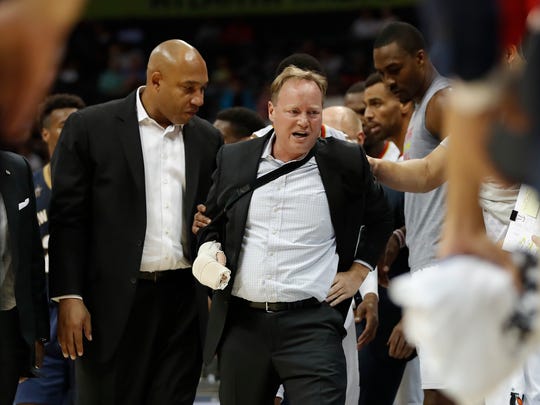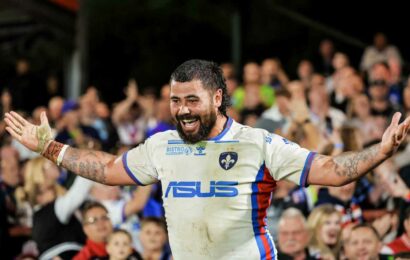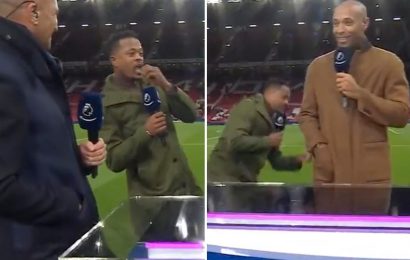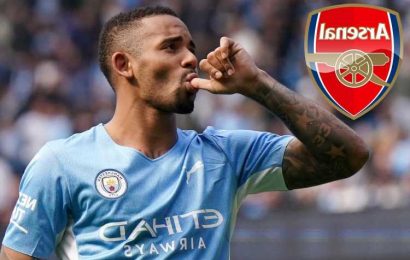The NBA has empowered its players and coaches by supporting their desire to address social injustices. Yet, the NBA has struggled with solving one of its own shortcomings.
“You look at the dichotomy between players, coaches and front office ownership representation. The percentages don’t match,” Denver Nuggets associate head coach Wes Unseld Jr. told USA TODAY Sports. “The NBA is by far more forward thinking, more proactive and more diverse and inclusive than the other sports leagues. But I think it still has a ways to go.”
Among the 30 NBA teams, there are four majority owners that are minorities and four women that have team ownership positions. There are 10 Black general managers, one Latino president of Basketball Operations and one Asian general manager. And there are zero women head coaches, seven Black head coaches and eight women assistant coaches.
“The only way it changes is if the decision-making field gets more diverse,” Milwaukee Bucks assistant coach Darvin Ham told USA TODAY Sports.
Scrutiny has intensified specifically surrounding the number of Black NBA head coaches for reasons beyond more attention this past year on the country’s racial inequalities.
Darvin Ham (left) has been one of Mike Budenholzer's assistant coaches since 2013 while with the Atlanta Hawks. He is now the associate head coach on Budenholzer's staff with the Milwaukee Bucks. (Photo: AP)
The NBA previously had eight Black head coaches at the beginning of the 2018-19 season and 14 during the 2012-13 season. That hardly matches the Black representation elsewhere. Out of the league's 185 assistant-coaching positions, 85 of the coaches are people of color. Meanwhile, 74.2% of the NBA players are Black.
“These numbers are just disgraceful. It doesn’t make any sense,” National Basketball Players Association executive director Michele Roberts told USA TODAY Sports. “It’s not as if no one is doing anything at all. It’s not as if teams aren’t uttering the right words. But the players are seeing it. I’m hearing people talk about both publicly and privately that these numbers don’t make sense.”
What will it take for these numbers to improve? What will it take for these numbers to become stable? And what will it take for these numbers to result in better inclusion?
“It’s going to take certainly more than we’re doing now,” NBA Commissioner Adam Silver said recently on a conference call. “We’ve made progress over the years. But we’re constantly looking at how we can do better.”
Tackling the diversity problem
To address this problem, the NBA and the NBA Basketball Coaches Association are brainstorming and finalizing various initiatives in hopes to improve the diversity among head coaches.
“We’ve been working on this quite diligently and have some things that are underway that we hope will start to deliver some results,” Oris Stuart, the NBA's chief diversity and inclusion officer, told USA TODAY Sports. “We’re always working on responses to the situation and to the environment, not only with head coaches and front office roles but across our business.”
This comes on the heels of the NBCA and various coaches criticizing the Minnesota Timberwolves for not having an open coaching search and interviewing a diverse number of candidates after firing coach Ryan Saunders. Instead, Timberwolves president of basketball operations Gersson Rosas hired Toronto Raptors assistant coach Chad Finch less than a day after Saunders’ firing.
Rosas also received league-wide criticism for hiring Finch, who is white, at the expense of Timberwolves associate head coach David Vanterpool, who is Black. Vanterpool had varying NBA and overseas playing stints (1995-2007), assistant-coaching gigs with CSKA Moscow in Russia (2007-10) and the Portland Trail Blazers (2012-19) and as the Oklahoma City Thunder’s director of player personnel (2010-12).
Make it make sense. Respectfully. https://t.co/4crtNzWV0W
“He’s more than enough paid his dues. He’s played the game at a high level, has been in a front office and has coached at a high level,” Ham said of Vanterpool. “Just based on the track record, this person deserves the opportunity. Chris Finch is a great coach. But to do it in that manner?”
Incidentally, Rosas became the NBA’s first and lone Latino to run a team’s front office last year. He also has overseen a diverse staff that includes an Indian American executive vice president of basketball operations (Sachin Gupta), a white general manager (Scott Layden), a Black assistant general manager (Joe Branch), an Italian assistant GM (Gianluca Pascucci) and a white assistant GM (Emmanuel Rohan). Saunders had two Black assistant coaches (Vanterpool, Kevin Burleson), two white assistants (Bryan Gates, Kevin Hanson) and one Latino assistant (Pablo Prigioni).
Rosas has said he wanted a more experienced coach after Saunders’ tenure proved unsuccessful. Rosas, who worked in the Houston Rockets’ front office (2003-2019), knew Finch from when he served as an assistant there (2011-16) before having associate head-coaching roles in Denver (2016-17) and New Orleans (2017-20).
“I know there are more hurdles for minorities," Rosas told USA TODAY Sports. "I had to leap over those personally, and it’s why I put internal programs in place to help all of our staff be prepared for the next step. I know David’s day will come, and we will continue to do what we can to develop him.”
Those in NBA circles believe that incident captured, both for better and for worse, how past relationships play a significant factor in the hiring process.
“People tend to turn to the people who they know best and they’re most familiar with,” Silver said. “In certain cases, you have a network of relationships that go back many years. To the extent that people aren’t part of those networks, they’re clearly at a disadvantage in the process. One of the things the league can do in working with our teams, therefore, is focus on a better process that ensures that everyone has an equal opportunity to sort of join the fraternity.”
'NBA Coaches Equality Initiative'
Just over three years ago, Dallas Mavericks coach Rick Carlisle, who is also the president of the NBCA, spoke about that issue with Silver, Stuart and the NBA’s president of social responsibility and player programs (Kathy Behrens).
“A lot of our African American coaches felt they were not getting the opportunity to get interviews for head-coaching positions,” Carlisle said. “Some of our female coaches weren’t getting the same kinds of opportunities. And some of our older coaches were concerned that they were being overlooked at times. So I talked to [Adam] about the need to have an initiative about the need to address these things.”
What did the NBA make of that feedback?
“That conversation really shined a light on what we had been observing ourselves and were aware of that we didn’t have the representation, in particular Black people in head-coaching roles as they were represented in the assistant-coaching ranks,” Stuart said. “That conversation really brought and highlighted the fact that we were in a position to take action.”
The NBA and the NBCA then created the “NBA Coaches Equality Initiative,” which led to various workshops and networking opportunities.
At Vegas Summer League in 2019, the league hosted a two-day summit that featured various panels and guest speakers. Minority coaches detailed their struggles breaking into the industry. Owners and general managers addressed their hiring process and what they look for in job interviews. An accomplished former NBA coach (Phil Jackson) and a current Black NFL coach (Mike Tomlin) also spoke.
“We want to create a situation where there’s an equal opportunity for development, and an equal opportunity for awareness,” Carlisle said. “We decided not to go the route of trying to set up a quota system. It’s been proven in other sports that quota systems are very flawed. They really don’t work in a lot of situations.”
Wes Unseld Jr., who was promoted to associated head coach with the Nuggets before the start of this season, said about diversity among NBA head coaches, “You look at the dichotomy between players, coaches and front office ownership representation. The percentages don’t match.” (Photo: Isaiah J. Downing, Isaiah J. Downing-USA TODAY Spor)
Therefore, the NBA has no plans on emulating the NFL’s so-called “Rooney Rule,” which has required teams since 2002 to include minority candidates during any coaching search. Last year, the NFL expanded that rule for teams to include at least two minority candidates and that teams would receive draft picks if they lose a minority staff member to another head-coaching job. Roberts called that policy “a relative failure” considering the NFL fields the same number of Black head coaches since first instituting the rule (three).
Instead, the NBA and NBCA consulted with the league’s coaches, general managers and decision makers to create the “Coaches Database,” a secure online resource that has profiles on every head and assistant coaches as well as qualified candidates. Since launching the database last summer, the NBA said it has about 275 coaching profiles, including one from every active NBA head and assistant coach. The league added more than 100 team decision makers have enrolled in the database. The NBA said this tool has helped decision makers become more aware of candidates they were previously unfamiliar with, and include them in job interviews.
“There’s no coach that I know who wants to get hired based on his skin color, but they want a fair opportunity,” Silver said. “Part of that is ensuring that we’re developing coaches appropriately in the pipeline, that they’re getting the right opportunities to interview and the right opportunities to network as other coaches have historically done.”
Where does the NBA go from here?
Some NBA Black head coaches and assistant coaches believe the "NBA Coaches Equality Initiative" have spurred enough action with creating more opportunities to network with decision makers and for them to become more familiar with their background through the database. They added these initiatives have led to more entry-level opportunities as well as pay increases for more experienced assistant coaches.
Still, Black NBA head and assistant coaches shared mixed feelings both with the stagnant numbers and the job interview process.
“We want to create a situation where there’s an equal opportunity for development, and an equal opportunity for awareness. We decided not to go the route of trying to set up a quota system. It’s been proven in other sports that quota systems are very flawed. They really don’t work in a lot of situations.”
Though some had optimism the numbers would improve within the next few years, others believe the NBA needs to address its lack of front office and ownership diversity before seeing any significant change. The Institute for Diversity and Ethics in Sport at the University of Central Florida’s gave NBA ‘F’ grades for its racial and gender hiring practices for NBA team president and CEOs.
Though some touted the importance of landing job interviews for educational and networking purposes, others say candidates often feel teams bring them in just to probe for information about another team.
“Is it a vetting out interview, or is there a serious candidate interview – that’s the concern that a lot of people I’ve spoken to have expressed,” former Atlanta Hawks coach Lloyd Pierce told USA TODAY Sports shortly before he was recently fired and replaced by assistant Nate McMillan, another Black coach. “What is the criteria for the position that each team is looking for, and is that being explained before they are being called to interview. When you see 20 interviews for one job, what are they looking for? How do you know how to prepare for the interview properly before taking an interview? I think a concern is a lot of the guys don’t want to be losing the job based on the interview. You interview five to 10 times, suddenly you’re considered a 'bad interview guy.' Does that hurt you?”
That partly explains why the NBA created the “Chief People and Inclusion Officer” position last summer. Since then, Stuart has overseen diversity and inclusions strategies for the NBA, WNBA, G-League and NBA 2K league and all of its teams. Though the NBA stressed teams have autonomy on its hiring practices, it believes this position will help lead toward more diversity and inclusion among the league’s 30 teams.
“Our objective is whenever a team is making a decision around any role, particularly a leadership role, that they would consider a wide diversity of candidates as part of that process,” Stuart said. “We’ll continue to encourage that and continue to build resources that enable that.”
So despite the NBA’s self admittance that its diversity and inclusion efforts need to improve, the league still received high marks in the Institute for Diversity and Ethics in Sport study in overall racial hiring (A+), gender hiring (B) and an overall grade (A-).
The Detroit Pistons have taken that lead. Pistons owner Tom Gores has overseen the hiring of a Black head coach (Dwane Casey), a Black general manager (Troy Weaver) as well as two other Black men (Michael Lindo, Harold Ellis) and two Black women (Britta Brown, Jhonika Hawkins) that have other front office roles.
“It’s the opportunity of getting the young African American coaches in front of owners, general managers and developing those relationships. But I don’t see any barriers or feel any barriers of color or race if a guy is qualified,” Casey told USA TODAY Sports. “I came up through the 60’s and the 70’s when there wasn’t the diversity that there is today. There’s a huge difference. It starts with Adam and his attitude toward it.”
Silver’s attitude captures both confidence and humility. He maintained, “in terms of the progress we’ve made in terms of diversity, I would hold us up to virtually any other company.” He conceded, however, “I don’t think there are any quick fixes.”
Follow USA TODAY NBA writer Mark Medina on Twitter, Facebook and Instagram.
Source: Read Full Article








